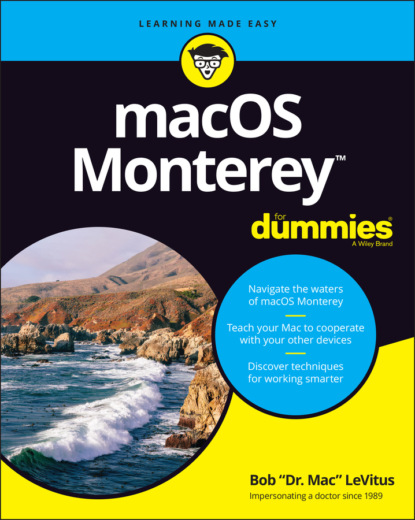alt="Remember"/> One useful function of the dock is that you can use it to open an application quickly and easily. The following tips explain several handy ways to open what you need from the dock:
You can drag a document icon onto an application’s dock icon. If the application knows how to handle that type of document, its dock icon is highlighted, and the document opens in that application. If the application can’t handle that particular type of document, the dock icon isn’t highlighted, and you can’t drop the document onto it. I’m getting ahead of myself here, but if the application can’t handle a document, try opening the document this way: Select the document icon and choose File ⇒ Open With, or right-click/Control-click the document icon and use the Open With menu to choose the application you want to open the document with. And if you hold down the Option key, the Open With command changes to Always Open With, which enables you to change the default application that opens this document permanently.
You can find the original icon of any item you see in the dock by choosing Show in Finder from its dock menu. This trick opens the window containing the item’s actual icon and thoughtfully selects that icon for you.
Customizing Your Dock
The dock is a convenient way to get at oft-used icons. By default, the dock comes stocked with icons that Apple thinks you’ll need most frequently (refer to Table 3-1), but you can customize it to contain any icons that you choose, as you discover in the following sections. You also find out how to resize the dock to fit your new set of icons and how to tell dock icons what your preferences are.
Adding dock icons
Adding an application, file, or folder to the dock is as easy as 1-2-3:
1 Open a Finder window that contains an application, a document file, or a folder you use frequently. You can also drag an icon — including a hard drive icon — from the desktop or any Finder window.
2 Click the item you want to add to the dock.As shown in Figure 3-4, I chose the TextEdit application. (It’s highlighted.)
3 Drag the icon out of the Finder window and onto the dock.The icons to the left and right of the new icon magically part to make room for it. Note that the dock icon isn’t the actual item. That item remains wherever it was — in a window or on the desktop. The icon you see in the dock is a shortcut that opens the item. I briefly mentioned aliases (known as shortcuts in the Windows world) earlier, but the icon on the dock is actually an alias of the icon you dragged onto the dock.Furthermore, when you remove an icon from the dock, as you find out how to do in a moment, you aren’t removing the actual application, document, or folder. You’re removing only its shortcut from the dock.
FIGURE 3-4: Adding an icon to the dock is as easy as 1-2-3. Just drag the icon onto the dock.
Folder, disk, document, and URL icons must sit on the right side of the divider line in the dock; application icons must sit on the left side of it. Why does the dock force these rules upon you? I suppose that someone at Apple thinks this is what’s best for you. Who knows? But that’s the rule: apps on the left; folders, disks, documents, and URLs on the right.
Adding a URL to the dock works slightly differently. Here’s a quick way to add a URL to the dock:
1 Open Safari, and go to the page with a URL that you want to save in the dock.
2 Click the small icon that you find to the left of the URL in the address bar and drag it to the right side of the dividing line in the dock.
3 Release the mouse button when the icon is right where you want it in the dock.The icons in the dock slide over and make room, as shown in Figure 3-5, and the URL appears as a dock icon. From now on, when you click the URL icon that you moved to your dock, Safari opens to that page.
FIGURE 3-5: Drag the icon from Safari’s address bar to the right side of the dock.
Control-click (or click and hold down) and choose Options ⇒ Keep in Dock from the menu that pops up.
Drag the icon (for an application that’s currently open) off and then back to the dock (or to a different position in the dock) without letting go of the mouse button.
Removing an icon from the dock
Removing an item from the dock is as easy as 1-2-3 but without the 3:
1 Drag its icon off the dock and onto the desktop.
2 When you see the Remove bubble, release the icon (mouse button).
3 There is no Step 3.
You can also choose Remove from Dock in the item’s dock menu to get it out of your dock, but this way is way more fun.
Also, note that by moving an icon off the dock, you aren’t moving, deleting, or copying the item itself; you’re just removing its icon from the dock. The item is unchanged. The icon is sort of like a library catalog card: Just because you remove the card from the card catalog doesn’t mean that the book is gone from the library.
On the other hand, for those with Macs that once ran OS X 10.7 (Lion) or earlier versions and have since been upgraded to Monterey, your Documents and Applications folders should still be on your Monterey dock unless you removed them at some point.
Resizing the dock
If the default size of the dock bugs you, you can make the dock smaller and save yourself a lot
